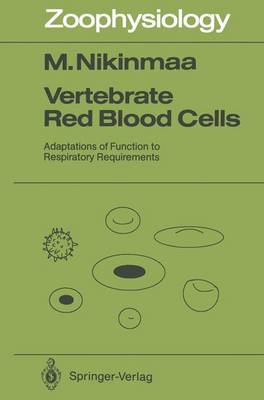(To see other currencies, click on price)
MORE ABOUT THIS BOOK
Main description:
This book reviews the respiratory function of vertebrate red cells. I have defined the phrase "respiratory function" broadly to include, in addition to the actual oxygen and carbon dioxide transport, erythropoiesis, haemoglobin synthesis, red cell structure, the deformability of red cells in circulation, ion and substrate transport across the cell membrane, cellular metabolism, and control of cellular volume and pH. All of these aspects of the red cell function may affect gas transport between the respiratory epithelia and the tissues. Throughout the book, I have tried to relate our current knowledge about the nucleated red cell function to the wealth of information about the function of mammalian red cells. However, whenever possible, I have placed the emphasis on the nucleated red cell function for two reasons. First, the erythro cytes of 90% of vertebrate species are nucleated, and, second, nucleated red cell function has not been reviewed earlier in a single volume. This being the case, I have tried to make the reference list as complete as I could with regard to nucleated red cells. I hope that the approach adopted is useful for both com parative and human physiologists. Many people have contributed to the making of this book directly or in directly. Antti Soivio started me in this field. Prof. Henrik Wallgren has always encouraged fresh scientific ideas in his department. My present ideas of red cell function have been influenced by work carried out with Prof. Roy E.
Contents:
1. Introduction.- 2. Erythropoiesis and the Control of Circulating Red Cell Number.- 2.1 Erythropoietic Sites.- 2.2 Mammalian Erythropoiesis.- 2.3 Erythropoiesis in Nonmammalian Vertebrates.- 2.3.1 Fish.- 2.3.2 Amphibians.- 2.3.3 Reptiles.- 2.3.4 Birds.- 2.4 Senescence of Red Blood Cells.- 2.5 Erythropoiesis-Independent Factors Increasing Circulating Red Cell Number.- 3. The Biosynthesis and Structure of Haemoglobin.- 3.1 Uptake of Iron into Erythroid Cells.- 3.2 Haem Synthesis.- 3.3 Globin Synthesis.- 3.3.1 Structure of Globin Genes.- 3.3.2 Globin Chain Synthesis and Its Regulation.- 3.4 Subunit Assembly of Haemoglobin.- 3.5 Haemoglobin Structure in Vertebrates.- 3.5.1 Haemoglobin Heterogeneity in Adult Animals.- 3.5.2 Ontogenic Changes in Vertebrate Haemoglobins - Haemoglobin Switching.- 4. Structure of Circulating Red Cells.- 4.1 General Anatomy of the Cell.- 4.2 The Red Cell Membrane.- 4.2.1 Membrane Lipids.- 4.2.2 Structural and Membrane Proteins.- 5. Red Cells in Circulation: Factors Affecting Red Cell Shape and Deformability.- 5.1 Blood Viscosity.- 5.2 Deformability of Red Cells.- 5.2.1 Basic Principles.- 5.2.2 Methods for Measuring Red Cell Deformability.- 5.2.3 Deformation of Red Cells in Circulation.- 5.2.4 Factors Affecting Red Cell Deformability.- 6. Energy Metabolism and Regulation of Organic Phosphate Concentrations.- 6.1 Energy Consumption.- 6.2 Transport of Substrates into the Red Cells.- 6.2.1 Amino Acid Transport.- 6.2.2 Monosaccharide Transport.- 6.2.3 Transport of Nucleosides, Nucleic Acid Bases and Nucleotides.- 6.3 Glycolysis.- 6.4 Pentose Phosphate Pathway and Glutathione Metabolism.- 6.4.1 Pentose Phosphate Pathway.- 6.4.2 Glutathione Metabolism.- 6.5 Krebs Cycle and Oxidative Phosphorylation.- 6.6 Organic Phosphate Metabolism.- 6.6.1 Nucleotide Metabolism.- 6.6.2 Inositol Pentaphosphate Metabolism.- 6.7 Cellular Control of Red Cell Organic Phosphate Concentrations.- 6.7.1 Organic Phosphate Concentrations.- 6.7.2 Ontogenetic and Environmental Factors Influencing the Organic Phosphate Concentrations.- 7. Major Ion Transporting Pathways.- 7.1 Electrodiffusive Leak.- 7.2 Ion Channels.- 7.3 Anion Exchange.- 7.4 Ion Transport Coupled to Sodium or Potassium Gradient.- 7.4.1 Sodium/Potassium/Chloride Cotransport.- 7.4.2 Potassium/Chloride Cotransport.- 7.4.3 Alkali Metal/Proton Exchange.- 7.4.4 Sodium/Calcium Exchange.- 7.5 Active Transport.- 7.5.1 Sodium Pump.- 7.5.2 Calcium Pump.- 7.6 Membrane Potential.- 7.6.1 Gibbs-Donnan Equilibrium.- 7.6.2 Membrane Potential in the Presence of Active Transport.- 8. Control of Volume and pH.- 8.1 The Basic Model: Control of Red Cell pH and Volume in the Absence of Significant Secondarily Active Transport.- 8.1.1 Maintenance of the Steady-State Volume.- 8.1.2 Determinants of the Steady-State pH.- 8.1.3 pH and Volume Changes in Response to Carbon Dioxide Addition and Removal, and Acid and Base Loads.- 8.1.4 Volume Changes in Response to Osmotic Disturbances.- 8.2 Mammalian Red Cells.- 8.2.1 Human Red Cells.- 8.2.2 Ruminant Red Cells.- 8.2.3 Carnivore Red Cells.- 8.2.4 Rodent Red Cells.- 8.2.5 Lagomorpha Red Cells.- 8.3 Avian Red Cells.- 8.4 Reptilian Red Cells.- 8.5 Amphibian Red Cells.- 8.6 Fish Red Cells.- 8.6.1 Teleost Red Cells.- 8.6.2 Elasmobranch Red Cells.- 8.6.3 Agnathan Red Cells.- 9. Carbon Dioxide Transport.- 9.1 Distribution of Total Carbon Dioxide Content Between Red Cells and Plasma.- 9.2 Carbon Dioxide - Bicarbonate Equilibria.- 9.2.1 Uncatalyzed Interconversion Between Carbon Dioxide and Bicarbonate.- 9.2.2 Function of Carbonic Anhydrase.- 9.2.3 Role of Buffers.- 9.3 Formation of Carbamino Compounds.- 9.4 Mechanisms of Carbon Dioxide Excretion.- 10. Oxygen Transport.- 10.1 Haemoglobin-Oxygen Equilibria - Basic Principles.- 10.1.1 Oxygen Equilibrium Curve.- 10.1.2 Homotropic and Heterotropic Interactions.- 10.1.3 Effect of Haemoglobin Concentration.- 10.1.4 Temperature Effects.- 10.2 Methods for Determining Blood/Haemoglobin Oxygen Content and Oxygen Equilibrium Curves.- 10.2.1 Preparation of Blood or Haemoglobin Solutions for Determinations of Oxygen Equilibrium Curves.- 10.2.2 Methods for Determining Oxygen Equilibrium Curves.- 10.3 Molecular Aspects of Haemoglobin-Oxygen Binding.- 10.3.1 Binding of Oxygen to the Haem Group.- 10.3.2 Cooperativity.- 10.3.3 Bohr Effect.- 10.3.4 Binding of Organic Phosphates and Other Anions.- 10.4 Formation and Reduction of Methaemoglobin.- 10.5 Cellular and Molecular Adaptations of Haemoglobin Function to Variations in Respiratory Requirements.- 10.5.1 Ontogenetic Changes in Haemoglobin-Oxygen Affinity.- 10.5.2 Responses of Air-Breathers to High Altitude.- 10.5.3 Blood Oxygen Affinity in Burrowing Air-Breathers.- 10.5.4 Blood Oxygen Transport in Diving Animals.- 10.5.5 Red Cell Function in Hypoxic Water-Breathers.- 10.5.6 Blood Oxygen Affinity in Transition from Water-to Air-Breathing.- 10.5.7 Effects of Temperature on the Blood Oxygen Affinity in Poikilotherms.- 10.5.8 Blood Oxygen Transport in Relation to Activity and Physical Disturbances.- 10.5.9 Blood Oxygen Affinity in Hibernation, Aestivation and Torpor.- References.
PRODUCT DETAILS
Publisher: Springer (Springer-Verlag Berlin and Heidelberg GmbH & Co. K)
Publication date: December, 2011
Pages: 276
Weight: 423g
Availability: Available
Subcategories: Biochemistry, Haematology
From the same series




















